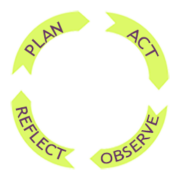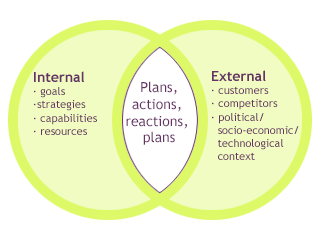-
What we do
We work with both the planned and the unplanned sides of organisational life. We work collaboratively to create open, listening climates where people can bring in their voices. We pool our and our clients' analytical thinking and intuitive common sense to find practical, creative solutions people can work with.
Everything we do involves learning and change and broadly falls into three areas:
Every organisation has an explicit task or job to do. How well it can do this depends on the dynamics that emerge as people interact every day, enabling and constraining each other. We are often asked to help change dynamics that are getting in the way of achieving goals.
We usually start by mapping the system we are working with, the goals of what we are looking to achieve, people’s roles and what is helping and getting in the way of achieving goals. There are often different views on these. Our normal response to differences is trying to persuade, dismiss or attack them. We introduce the systems-centered method of functional subgrouping to interrupt this and instead to listen to the information in the differences to make more effective decisions. Our overall goal is to build a climate where it is possible to reduce whatever is getting in the way of achieving goals.

Recent organisational change work
The company wanted to improve its product development process. We worked over a period of twelve months with an internal OD consultant to develop a cohort of internal coaches and to help the product developers take up their roles more effectively.
We ran off-sites to introduce the coaches and product developers to the Systems-Centered notions of Role, Goal and Context to take up roles effectively; the SAVI (System for Analysing Verbal Interaction) communications tool to improve problem-solving; the force-field as a way of diagnosing what’s helping and what’s getting in the way of achieving goals; the map of phases of team development to identify which behaviours are likely to help and which to get in the way of achieving goals; functional sub-grouping as a way of integrating differences; and emotional intelligence to use the information in both thinking and feeling to make better decisions.
As a result of the work, the product developers from different areas started working together as a team across the organisation. They identified ways to improve a key part of the product development process. The board sponsor said the project had ‘made my year’.
The context was a division of a large public sector organisation where staff were finding it hard to match the workload to the resources available, satisfaction was low and sick-leave was increasing. The client initially asked us to research best-practice and write a report telling them what to do. From experience, we believed this approach was unlikely to bring about any change.
We took a systems-oriented approach and involved the division in identifying the issues and coming up with potential solutions.
The overall goal of the project was to achieve a better match between resources and workload.
We started by: clarifying with the division the context of the wider organisation, the role and goals of the division and how these lined up with those of the organisation; working with the division and the wider organisation to identify what was helping and getting in the way of achieving these goals; making sense of this and exploring the implications with the senior management and wider division; coaching the senior management and the wider team to listen to their differences so they could use the information to problem-solve; identifying options for change; choosing what to do; and getting commitment to implement changes.
Twelve months later we did an evaluation of the impact with the team. Overall the initiative improved the division’s productivity, effectiveness and satisfaction by at least 8%.
From experience of working with clients in all sectors, protecting individual ‘turfs’, lack of clear, shared goals, fear of speaking up, scapegoating, complaining and blaming are significant impediments to collaborative system-wide working. Without a shared way of working with differences and clear roles and goals, these dynamics are likely to negatively impact development and transformation.
We see leadership as an emergent property of the interactions between formal leaders and followers. Leaders make gestures, but they cannot predict with certainty the responses these will elicit. We develop leadership capacity at all levels in organisations. We help leaders to stay open and curious in the face of the unknown, having compassion for themselves and others, and accepting that organisational dynamics are the outcome of many local interactions that we can influence but not control.
Team climates where conversations are open and exploratory, rather than closed, avoidant, fighting or competitive, increase our satisfaction and ability to use our emotional intelligence to problem-solve. Our common human challenge is to build enough trust to have honest and open conversations so we can cooperate on a common task.
We teach the systems-centered method of functional subgrouping and introduce the SAVI Grid to reduce reactivity and increase listening to different views.
We use a Phases of Team Development map to normalise that all human systems go through predictable (though not linear) phases (e.g. Flight and Fight). The phase both influences how we behave, and we can influence it, often by ‘just’ shifting our verbal behaviours.
Role, Goal and Context. We know that making a useful contribution to any system increases if we are mindful of the context, its goals and our roles. This sounds simple and, from experience, it is complex. We coach leaders (and followers) at all levels in organisations to mindfully step into the many different roles and contexts they enter each day. We help them identify behaviours that support themselves, their role and the context. We encourage using their thinking and feelings to make decisions and to stay curious in the face of uncertainty.

Recent leadership and collaborative team working examples
We have worked with leaders and teams in the for-profit, public and voluntary sectors to get clarity about the context they are working in, identify their explicit and implicit goals and what behaviours are likely to support them in their roles and achieve organisational goals. We help identify and reduce what is getting in the way of working effectively so strengths can come through. We teach communications skills, systems thinking and tools, and build capacity to work effectively together.
In a private sector leadership team that was fighting and unable to solve quality and sales issues, functional subgrouping enabled people to listen to each other in a way they found moving and to start to address the task issues. They knew the cost of their usual interrupting, Yes-butting each other and complaining / blaming but did not have an alternative. The SAVI® (System for Analyzing Verbal Interaction) Grid helped them see why their usual patterns got in the way of information transfer and increased personal reactivity, and how functional subgrouping helped increase their ability to listen to each other and problem-solving.
In a team of social care managers, applying we worked to reduce complaining, blaming and scapegoating and enabled the managers to collect data on what they were doing that was helping and getting in the way of taking up their roles functionally. Managers were able to step into their roles with more authority, which in turn increased their ability to lead their teams, and to help each other when they felt at a loss about what to do.
We see strategy as a process, not a one-off exercise. A plan gives a focus for action. It also needs continual updating as people learn by doing and the context constantly changes. We are skilled at identifying themes with clients and building up coherent pictures of what is happening. Our skills in organisational change help engage people to bridge the crucial gap between research and action.
Most of our work starts with some form of internal and external research to:
- Understand the existing implicit and explicit strategy (often very different)
- Discover what’s helping and what’s getting in the way of meeting goals
- Identify resources and knowledge (often hidden in unlikely places in organisations) to address issues

Recent strategy work
The organisation was growing and senior management wanted to check how existing clients viewed the brand. We researched brand perceptions among existing clients and mapped these onto how people in the consultancy saw the brand. We facilitated workshops to jointly make sense of the research and to identify how to address weaknesses and build on strengths. In the CEO's words, the process was "invaluable" in shifting the organisation to be more client-focused and helping team members and leaders to engage with some of the issues that were blocking them from developing further.
The senior management team initially wanted us to research the needs of potential new members.
We went in with an open mind and, from our initial meeting, had a sense they were overwhelmed with initiatives and needed to focus on existing members before recruiting new ones. They confirmed being overwhelmed. The difficulty was they needed to meet targets for new members set by the Board. We asked questions and facilitated meetings. This helped them step back, review their existing information and resources and re-assess their priorities. The issues they were facing became clearer, e.g. needing to upgrade their member database and website and get some activity-based costing data. Our questions threw light on the fact that they were already meeting their recruitment targets and had a breathing space of several months before looking for more members. In the client’s words, our ‘insights, analysis and facilitative approach brought essential clarity to a complex issue enabling the team to identify key objectives, and develop a robust longer term strategy.’
